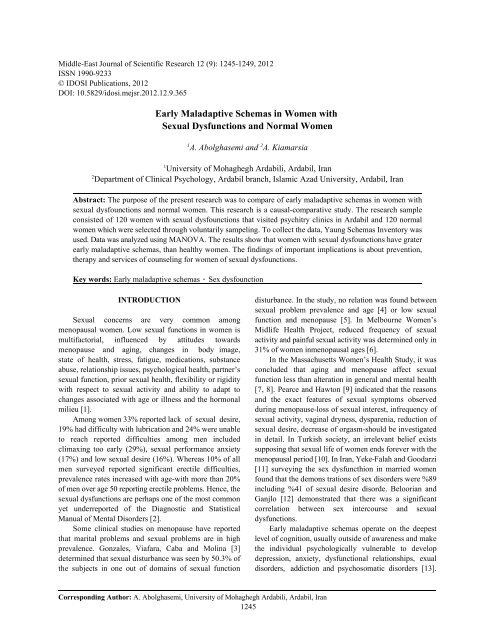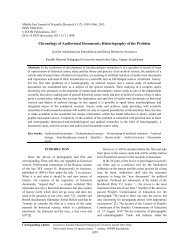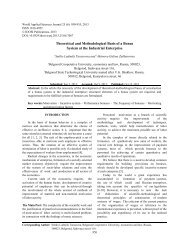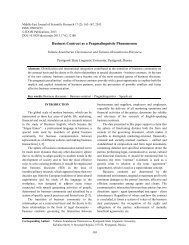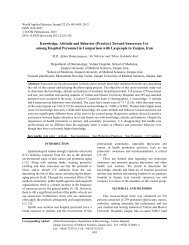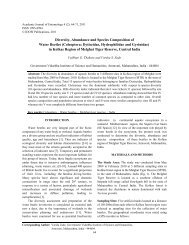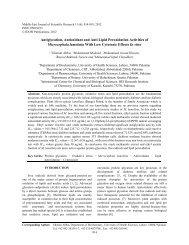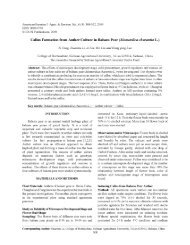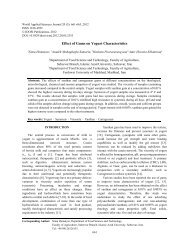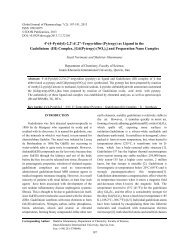Early Maladaptive Schemas in Women with Sexual Dysfunctions ...
Early Maladaptive Schemas in Women with Sexual Dysfunctions ...
Early Maladaptive Schemas in Women with Sexual Dysfunctions ...
Create successful ePaper yourself
Turn your PDF publications into a flip-book with our unique Google optimized e-Paper software.
Middle-East Journal of Scientific Research 12 (9): 1245-1249, 2012<br />
ISSN 1990-9233<br />
© IDOSI Publications, 2012<br />
DOI: 10.5829/idosi.mejsr.2012.12.9.365<br />
<strong>Early</strong> <strong>Maladaptive</strong> <strong>Schemas</strong> <strong>in</strong> <strong>Women</strong> <strong>with</strong><br />
<strong>Sexual</strong> <strong>Dysfunctions</strong> and Normal <strong>Women</strong><br />
1 2<br />
A. Abolghasemi and A. Kiamarsia<br />
1<br />
University of Mohaghegh Ardabili, Ardabil, Iran<br />
2<br />
Department of Cl<strong>in</strong>ical Psychology, Ardabil branch, Islamic Azad University, Ardabil, Iran<br />
Abstract: The purpose of the present research was to compare of early maladaptive schemas <strong>in</strong> women <strong>with</strong><br />
sexual dysfounctions and normal women. This research is a causal-comparative study. The research sample<br />
consisted of 120 women <strong>with</strong> sexual dysfounctions that visited psychitry cl<strong>in</strong>ics <strong>in</strong> Ardabil and 120 normal<br />
women which were selected through voluntarily sampel<strong>in</strong>g. To collect the data, Yaung <strong>Schemas</strong> Inventory was<br />
used. Data was analyzed us<strong>in</strong>g MANOVA. The results show that women <strong>with</strong> sexual dysfounctions have grater<br />
early maladaptive schemas, than healthy women. The f<strong>in</strong>d<strong>in</strong>gs of important implications is about prevention,<br />
therapy and services of counsel<strong>in</strong>g for women of sexual dysfounctions.<br />
Key words: <strong>Early</strong> maladaptive schemas<br />
Sex dysfounction<br />
INTRODUCTION<br />
disturbance. In the study, no relation was found between<br />
sexual problem prevalence and age [4] or low sexual<br />
<strong>Sexual</strong> concerns are very common among function and menopause [5]. In Melbourne <strong>Women</strong>’s<br />
menopausal women. Low sexual functions <strong>in</strong> women is Midlife Health Project, reduced frequency of sexual<br />
multifactorial, <strong>in</strong>fluenced by attitudes towards activity and pa<strong>in</strong>ful sexual activity was determ<strong>in</strong>ed only <strong>in</strong><br />
menopause and ag<strong>in</strong>g, changes <strong>in</strong> body image, 31% of women <strong>in</strong>menopausal ages [6].<br />
state of health, stress, fatigue, medications, substance In the Massachusetts <strong>Women</strong>’s Health Study, it was<br />
abuse, relationship issues, psychological health, partner’s concluded that ag<strong>in</strong>g and menopause affect sexual<br />
sexual function, prior sexual health, flexibility or rigidity function less than alteration <strong>in</strong> general and mental health<br />
<strong>with</strong> respect to sexual activity and ability to adapt to [7, 8]. Pearce and Hawton [9] <strong>in</strong>dicated that the reasons<br />
changes associated <strong>with</strong> age or illness and the hormonal and the exact features of sexual symptoms observed<br />
milieu [1].<br />
dur<strong>in</strong>g menopause-loss of sexual <strong>in</strong>terest, <strong>in</strong>frequency of<br />
Among women 33% reported lack of sexual desire, sexual activity, vag<strong>in</strong>al dryness, dysparenia, reduction of<br />
19% had difficulty <strong>with</strong> lubrication and 24% were unable sexual desire, decrease of orgasm-should be <strong>in</strong>vestigated<br />
to reach reported difficulties among men <strong>in</strong>cluded <strong>in</strong> detail. In Turkish society, an irrelevant belief exists<br />
climax<strong>in</strong>g too early (29%), sexual performance anxiety suppos<strong>in</strong>g that sexual life of women ends forever <strong>with</strong> the<br />
(17%) and low sexual desire (16%). Whereas 10% of all menopausal period [10]. In Iran, Yeke-Falah and Goodarzi<br />
men surveyed reported significant erectile difficulties, [11] survey<strong>in</strong>g the sex dysfuncthion <strong>in</strong> married women<br />
prevalence rates <strong>in</strong>creased <strong>with</strong> age-<strong>with</strong> more than 20% found that the demons trations of sex disorders were %89<br />
of men over age 50 report<strong>in</strong>g erectile problems. Hence, the <strong>in</strong>clud<strong>in</strong>g %41 of sexual desire disorde. Beloorian and<br />
sexual dysfunctions are perhaps one of the most common Ganjlo [12] demonstrated that there was a significant<br />
yet underreported of the Diagnostic and Statistical correlation between sex <strong>in</strong>tercourse and sexual<br />
Manual of Mental Disorders [2].<br />
dysfunctions.<br />
Some cl<strong>in</strong>ical studies on menopause have reported <strong>Early</strong> maladaptive schemas operate on the deepest<br />
that marital problems and sexual problems are <strong>in</strong> high level of cognition, usually outside of awareness and make<br />
prevalence. Gonzales, Viafara, Caba and Mol<strong>in</strong>a [3] the <strong>in</strong>dividual psychologically vulnerable to develop<br />
determ<strong>in</strong>ed that sexual disturbance was seen by 50.3% of depression, anxiety, dysfunctional relationships, exual<br />
the subjects <strong>in</strong> one out of doma<strong>in</strong>s of sexual function disorders, addiction and psychosomatic disorders [13].<br />
Correspond<strong>in</strong>g Author: A. Abolghasemi, University of Mohaghegh Ardabili, Ardabil, Iran<br />
1245
Middle-East J. Sci. Res., 12 (9): 1245-1249, 2012<br />
When a schema is triggered, the <strong>in</strong>dividual may others’ needs, <strong>with</strong> male-to-female transsexuals<br />
respond to it <strong>with</strong> a maladaptive cop<strong>in</strong>g style (e.g., conceptualiz<strong>in</strong>g themselves also as more vulnerable and<br />
overcompensation, avoidance, surrender) that deficient than controls.<br />
perpetuates the schema [14]. <strong>Early</strong> maladaptive schemas In view of the above, the present study<br />
are thought to be trait-like [15] <strong>in</strong> that they are stable over attempted to extend or improve upon the previous<br />
time. Recently, this assumption has been supported by research <strong>in</strong> one way. Due to the relative neglect <strong>in</strong><br />
empirical f<strong>in</strong>d<strong>in</strong>gs show<strong>in</strong>g high stability correlations over psychology, the research that comparison of early<br />
a 2.5-5 year <strong>in</strong>terval despite significant changes <strong>in</strong> maladaptive schemas of women <strong>with</strong> sexual<br />
depression severity [16]. However, an early maladaptive dysfounctions and normal women, could prove useful.<br />
schemas is not necessarily activated at every moment. In To beg<strong>in</strong> the study, we anticipated that women <strong>with</strong><br />
order to account for rapid shifts <strong>in</strong> emotional state, e.g., <strong>in</strong> sexual dysfounctions have grater early maladaptive<br />
patients suffer<strong>in</strong>g from borderl<strong>in</strong>e or antisocial personality schemas than normal women .<br />
disorder [17].<br />
Oliveir and Nobre [18] showed that is strong<br />
MATERIALS AND METHODS<br />
correlations between sexual function<strong>in</strong>g and positive<br />
affect, cognitive schemas (deprivation, defectiveness/ Participants: This research is a causal-comparative study.<br />
shame, vulnerability to danger and subjugation) and This study <strong>in</strong>cluded 120 women <strong>with</strong> sexual<br />
different psychopathology dimensions. <strong>Women</strong> less dysfounctions that visited psychiatry cl<strong>in</strong>ics <strong>in</strong> Ardabil<br />
sexually functional presented significant higher levels and exam<strong>in</strong>at<strong>in</strong>g accord<strong>in</strong>g to DSM-IV criteria [24]. The<br />
of positive affect dur<strong>in</strong>g sexual activity and higher levels comparison group of 120 normal women deemed eligible<br />
of <strong>in</strong>sufficient self-control, emotional <strong>in</strong>hibition, social if they were reported no current or previous history of<br />
isolation, abandonment, emotional deprivation and sexual disorders or psychiatric compla<strong>in</strong>ts dur<strong>in</strong>g<br />
<strong>in</strong>competence schemas, when compared <strong>with</strong> a sexually screen<strong>in</strong>g for study eligibility. The sample covered an age<br />
functional group. Nobre [19] showed that patterns of range of 30-50 years (mean=39.5 years; SD=8.4 years).<br />
association and overlapp<strong>in</strong>g among the different sexual<br />
dysfunction <strong>in</strong> men and women <strong>in</strong>dicated high Instruments: The Schema Questionnaire-Short Form (SQcorrelations<br />
between all dimensions of sexual function<strong>in</strong>g. SF; Young) measures 15 early maladaptive schemas [25].<br />
The study of Bradford and Meston [20] showed that trait The scales consist of the five items <strong>with</strong> the highest<br />
anxiety and anxiety sensitivity were correlated <strong>with</strong> self- load<strong>in</strong>gs on the 15 factors that emerged <strong>in</strong> a factor<br />
reported sexual arousal outside the laboratory. Balc, analysis of the long form of the SQ [26]. EMS are grouped<br />
Guls_CSozer, Engun and Kukulua [21] found that <strong>in</strong> five broad doma<strong>in</strong>s: disconnection and rejection<br />
depression was determ<strong>in</strong>ed <strong>in</strong> 29.3% of women and sexual (abandonment, mistrust, emotional deprivation,<br />
dysfunction <strong>in</strong> 65% of women. Significant negative defectiveness and social isolation), impaired autonomy<br />
relation was found between sub-dimension of sexual and performance (dependence, vulnerability, enmeshment<br />
function scale of women vag<strong>in</strong>al slickness, orgasm, pa<strong>in</strong>, and failure), impaired limits (entitlement and <strong>in</strong>sufficient<br />
total sexual dysfunction and depression po<strong>in</strong>t. The results self-control), other-directedness (subjugation, selfof<br />
study Donaghue [22] showed that body satisfaction sacrifice and approval-seek<strong>in</strong>g) and overvigilance and<br />
and dimensions of women’s actual sexual self-schemas <strong>in</strong>hibition (negativity, emotional <strong>in</strong>hibition, unrelent<strong>in</strong>g<br />
predicted satisfaction <strong>with</strong> life, positive and negative standards and punitiveness). Respondents are asked to<br />
affect. The relationships between body satisfaction and rate statements on a six po<strong>in</strong>t Likert scale from<br />
both positive affect and satisfaction <strong>with</strong> life were “completely untrue of me” to “describes me perfectly”.<br />
partially mediated by the positive dimensions of sexual The SQ-SF has <strong>in</strong> different studies shown adequate<br />
self-schemas. Simon, Zsolt, Fogd and Czobor [23] reliability, validity <strong>in</strong> predict<strong>in</strong>g psychopathology and<br />
showed that subjects <strong>with</strong> gender identity disorder factor structure [27, 28]. Cronbach’s alphas for the various<br />
demonstrated a level of psychiatric distress comparable to subscales at the two different assessments varied from. 85<br />
that of controls. They did display elevated scores, to. 95 [29]. In Iran, Ghyasi and et al [30] Cronbach’s<br />
however, on multiple early maladaptive schemas alphas reported for the various subscales at the two<br />
compared to nontranssexual subjects, <strong>in</strong>dicat<strong>in</strong>g feel<strong>in</strong>gs different assessments varied from. 60 to. 86. The<br />
of isolation, emotional deprivation and an urge to meet concurrent validity was of. 64.<br />
1246
Middle-East J. Sci. Res., 12 (9): 1245-1249, 2012<br />
Procedure: Participants were selected from among the<br />
women <strong>with</strong> sexual disorders and normal women of the<br />
among psychiatry centers. Each subject completed the<br />
questionnaire and returned it to the researcher. The<br />
questionnaires took approximately 45 m<strong>in</strong>utes to<br />
complete. The study measures were adm<strong>in</strong>istrated <strong>in</strong> the<br />
follow<strong>in</strong>g order: The Young Schema Questionnaire.<br />
RESULTS<br />
Table 1 shows the Mean and Standard Deviation, for<br />
early maladaptive schemas <strong>in</strong> <strong>in</strong> wamen <strong>with</strong> sexual<br />
dysfounctions and normal normal. As demonstrated <strong>in</strong><br />
table 1, the mean scores of early maladaptive schemas<br />
were 202.25 <strong>in</strong> normal women and <strong>in</strong> normal women 65.71.<br />
The research [31] demonstrat<strong>in</strong>g the mean over 3 <strong>in</strong> each<br />
subscale as an <strong>in</strong>decative of maladaptive schemas, was<br />
used to determ<strong>in</strong>e the early maladaptive schemas <strong>in</strong><br />
women <strong>with</strong> sexual dysfounctions and normal women.<br />
The results <strong>in</strong>dicates that are early maladaptive schemas<br />
of emotional deprivation, abandonment/ <strong>in</strong>stability, social<br />
isolation / alienation, failure, enmeshment/undevelopedself,<br />
self-sacrifiee, Subjugation, emotional <strong>in</strong>hibition,<br />
unrelent<strong>in</strong>g Standards/ hypercriticalness,<br />
emtitlement/grandiosity and <strong>in</strong>sufficient self-disipl<strong>in</strong>e <strong>in</strong><br />
<strong>with</strong> sexual dysfounctions.<br />
Table 1: Means and standard deviations of early maladaptive schemas <strong>in</strong><br />
wamen <strong>with</strong> sexual dysfounctions and normal women<br />
normal women<br />
frigid women<br />
---------------------------- ----------------------------<br />
Variable M SD M SD<br />
ED 2.25 1.15 3.03 1.31<br />
AI 2.41 1.09 3.16 1.10<br />
MA 1.96 1.05 2.60 .85<br />
SI 1.95 1.08 3.02 1.06<br />
DS 2.21 1.18 2.97 1.38<br />
F 2.25 1.21 3.42 1.47<br />
DI 1.70 .96 2.37 .77<br />
VH 1.88 .95 2.73 1.13<br />
EU 2.05 .94 3.20 1.09<br />
SS 1.92 .85 33.3 1.29<br />
SB 2.47 1.38 3.41 1.22<br />
EI 2.08 1.19 3.35 1.11<br />
US 2.39 1.27 3.82 .93<br />
EG 2.32 1.26 3.61 .97<br />
IS 2.34 1.34 3.77 .86<br />
total 65.71 9.59 202.25 28.21<br />
Emotional Deprivation (ED), Abandonment/Instability (AI), Mistrust/Abuse<br />
(MA), Sicial Isolation/Alienation (SI), Defectiveness/Shame (DS), Failure<br />
(F), Dependence/Incompetence(DI), Vulnerability to Harm or Illness (VH),<br />
Enmeshment /Undeveloped-Self(EU, Self-Sacrifices(SS), Subjugation(SB),<br />
Emotional Inhibition(EI), Unrelent<strong>in</strong>g Standards/Hypercriticalness(US),<br />
Entitlement/Grandiosity(EG), Insufficient Self-Contorol/Self-discipl<strong>in</strong>e(IS)<br />
Table 2: Results of MANOVA analyses of early maladaptive schemas <strong>in</strong><br />
women <strong>with</strong> sexual dysfounctions and normal women<br />
Variable SS df MS F Sig<br />
ED 487.72 1 487.72 12.56 .000<br />
AI 443.12 1 443.12 13.91 .000<br />
MA 340.64 1 340.64 13.96 .000<br />
SI 833.23 1 833.23 28.6 .000<br />
DS 431.22 1 431.22 9.95 .000<br />
F 918.45 1 918.45 19.61 .000<br />
DI 263.77 1 263.77 14.02 .000<br />
VH 497.95 1 497.95 17.42 .000<br />
EU 747.19 1 747.19 26.60 .000<br />
SS 1228.09 1 1228.09 38.88 .000<br />
SB 573.84 1 573.84 13.88 .000<br />
EI 1102.02 1 1102.02 31.85 .000<br />
US 1477.81 1 1477.81 50.22 .000<br />
EG 1205.70 1 1205.70 39.09 .000<br />
IS 1518.37 1 1518.37 49.24 .000<br />
The significance test of MANOVA showed that there<br />
is a significant difference between women <strong>with</strong> sexual<br />
dysfounctions and normal women at least one of the<br />
dependent variables (Wilks’ lambda=0.792, F=27.25,<br />
P=0.001).<br />
The MANOVA results showed that there were<br />
significant differences between the emotional deprivation<br />
(F=12.56), abandonment /<strong>in</strong>stability (F=13.91),<br />
mistrust/abuse (F=13.96), sicial isolation/alienation<br />
(F=28.6), defecticness/shame (F=9.95), failure (F=19.61),<br />
dependence/<strong>in</strong>competence (F=14.02), vulnerability to<br />
harm or illness (F=17.42), self sacrifice (F=38.88),<br />
enmeshment/undeveloped-self (F=26.60), subjugation<br />
(F=13.88), emotional <strong>in</strong>hibition (F=31.85), unrelent<strong>in</strong>g<br />
standards/hypercriticalness (F=50.22),<br />
entitlement/grandiosity (F=39.09) and <strong>in</strong>sufficient selfcontorol/self-discipl<strong>in</strong>e<br />
(F=49.24) <strong>in</strong> frigid and normal<br />
women (P
Middle-East J. Sci. Res., 12 (9): 1245-1249, 2012<br />
relatives. The results approve the f<strong>in</strong>d<strong>in</strong>gs of Oliveir and those of other researchers. Oliver and norbe come to<br />
Nobre [18], Nobre [19] and Zsolt, Fogd and Czobor [23]. conclusion that unlike healthy women, those <strong>with</strong> sexual<br />
The maladoptive schema of emotional deprivation dysfounctions experiencod move anxiety, stress,<br />
<strong>in</strong> women <strong>with</strong> sexual dysfunction was consideed as an depression, emotional <strong>in</strong>hibition and <strong>in</strong>sufficient selfimportant<br />
variable, s<strong>in</strong>ce they feel misunderstard<strong>in</strong>g, lack control [18].<br />
of sympathy, defectiveness and lack of support by their In conclusion, the results from the present study<br />
husbomds affect<strong>in</strong>g their sex relationships. The support of role of early maladaptive schemas on women<br />
maladoptive schema of social isolation/alienation was sexual dysfunctions. This study provides significant<br />
another determ<strong>in</strong><strong>in</strong>g variable. <strong>Women</strong> <strong>with</strong> sex f<strong>in</strong>d<strong>in</strong>gs about the presence of early maladaptive schemes<br />
dysfunctions feel more isolation and alienation.<br />
and sexual dysfunctions risk factors and its awareness <strong>in</strong><br />
The results of the study showed that the mean of the studied population. In order to <strong>in</strong>vestigate emotive<br />
failure scheme <strong>in</strong> women <strong>with</strong> sexual dysfounctions is and cognitive dimensions of this problem <strong>in</strong> detail,<br />
significantly great than normal women (p
Middle-East J. Sci. Res., 12 (9): 1245-1249, 2012<br />
11. Yeke-Falah, L. and M.R. Goodarzi, 2004. 23. Simon, L., U. Zsolt, D. Fogd and P. Czobor, 2011.<br />
<strong>Sexual</strong> Disorders and Effective Factors of <strong>in</strong> its. Dysfunctional Core Beliefs, Perceived Parent<strong>in</strong>g<br />
6th Congress <strong>Women</strong> <strong>in</strong> Iran, pp: 514-516.<br />
Behavior and Psychopathology <strong>in</strong> Gender Identity<br />
12. Beloorian, Z. and J. Ganglo, 2007. <strong>Sexual</strong> Disorders Disorder: A Comparison of Male-to-Female,<br />
and Some of Effective Related to its <strong>in</strong> Halthy Centers Female-to-Maletranssexual and Nontranssexual<br />
of Sabzevar City. Fertility andInfertility Faslnameh, Control Subjects. J. Behav. Ther. and Exp. Psychiat,<br />
8(2): 163-170. 42(1): 38-45.<br />
13. Young, J.E., 1999. Cognitive Therapy for Personality 24. American Psychiatric Association, 1994.<br />
Disorders: A Schema-Focused Approach (3rd ed.). Diagnostic and statistical manual of mental disorders<br />
Sarasota, FL: Professional Resource Exchange.<br />
(4th ed.). Wash<strong>in</strong>gton, DC.<br />
14. Young, J.E., J.S. Klosko and M. Weishaar, 2003. 25. Young, J.E., 2000. Young Parent<strong>in</strong>g Inventory (YPI)<br />
Schema Therapy: A practitioner’s Guide. New York: (On-l<strong>in</strong>e). New York: Cognitive Therapy Centre.<br />
Guilford Publications.<br />
Available From: http://www.schematherapy.com.<br />
15. Weishaar, M.E. and A.T. Beck, 2006. 26. Schmidt, N.B., T.E. Jo<strong>in</strong>er, J.E. Young and M.J. Telch,<br />
Cognitive Theory of Personality and Personality 1995. The Schema Questionnaire: Investigation of<br />
Disorders. In S. Strack (Ed.), Differentiat<strong>in</strong>g normal Psychometric Properties and the Hierarchical<br />
and abnormal personality (2nded.). (pp: 113e135) New Structure of a Measure of <strong>Maladaptive</strong> <strong>Schemas</strong>.<br />
York: Spr<strong>in</strong>ger. Cognitive Therapy and Research, 19(2): 295-301.<br />
16. Riso, L.P., S.E. Froman, M. Raouf, P. Gable, 27. Waller, G., R. Shah, V. Ohanian and P. Elliott, 2001.<br />
R.E. Maddux and N. Tur<strong>in</strong>i-Santorelli, 2006. Core Beliefs <strong>in</strong> Bulimia Nervosa and Depression:<br />
The long-term Stability of <strong>Early</strong> <strong>Maladaptive</strong> the Discrim<strong>in</strong>ant Validity of Young’s<br />
<strong>Schemas</strong>. Cognitive Therapy and Research, Schema-Questionnaire. Behavior Therapy,<br />
30(3): 515-529. 32: 139-153.<br />
17. Lobbestael, J., A. Arntz and S. Sieswerda, 2005. 28. Hoffart, A., H. Sexton, L.M. Hedley, C.E. Wang,<br />
Schema Modes and Childhood Bbuse <strong>in</strong> Borderl<strong>in</strong>e H. Holthe and J.A. Haugum, 2005. The Structure of<br />
and Antisocial Personality Disorders. Journal of <strong>Maladaptive</strong> <strong>Schemas</strong>: A Confirmatory Factor<br />
Behavior Therapy and Experimental Psychiatry, Analysis and a Psychometric Evaluation of<br />
36(2): 240-253. Factor-Derived Scales. Cognitive Therapy and<br />
18. Oliver, C. and P. Nobre, 2008. Female <strong>Sexual</strong> Research, 29(3): 627-644.<br />
Dysfunction: Therole of <strong>Schemas</strong> and Affect. 29. Wang, E.A., M. Halvorsen, M. Eisemann and<br />
Journal of Consult<strong>in</strong>g and Cl<strong>in</strong>ical Psychology, K. Waterloo, 2010. Stability of Dysfunctional<br />
TOP-O-38.<br />
Attitudes and <strong>Early</strong> <strong>Maladaptive</strong> <strong>Schemas</strong>: A 9-Year<br />
19. Nobre, P., 2000. Psychological Variabls<strong>in</strong> Male Follow-Up Study of Cl<strong>in</strong>ically Depressed Subjects.<br />
Ssexual Dysfunction: Cognitive <strong>Schemas</strong> and J. Behav. Ther. and Exp. Psychiat, 41(2): 389-396.<br />
Personality. Journal Sexologies, Top-O., pp: 130. 30. Ghiyasi, L., H. Molavi, H.T. Neshat-doost and<br />
20. Bradford, A. and C.M. Meston, 2006. The Impact of M. Mjhgan, 2008. The Factor Structure Study of Farsi<br />
Anxiety on <strong>Sexual</strong> Arousal <strong>in</strong> <strong>Women</strong>. Version of Young Schema Questionnaire-S3 <strong>in</strong> Two<br />
Behaviour Research and Therapy, 44(4): 1067-1077. Groups of Cl<strong>in</strong>ical and Non-Cl<strong>in</strong>ical Samples.<br />
21. Balc, H., P. Yang n, E. Guls, A. Sozera, S. Nazik and Journal of Psychological Achievements, Inpress.<br />
K. Kukulu, 2008. The Relationship Between 31. Nordal, A., M. Hans, H. Holth and A. Ion, 2005.<br />
Bepression and <strong>Sexual</strong> Function <strong>in</strong> Menopause <strong>Early</strong> <strong>Maladaptive</strong> <strong>Schemas</strong> <strong>in</strong> Potient With or<br />
Beriod. Maturitas, 61(2): 233-237.<br />
Without Personality Disorders. Cl<strong>in</strong>ical Psychology<br />
22. Donaghue, N., 2009. Body Satisfaction, and Psychotherapy, 12(1): 142-149.<br />
<strong>Sexual</strong> Self-<strong>Schemas</strong> and Subjective Well-Be<strong>in</strong>g <strong>in</strong><br />
<strong>Women</strong>. Body Image, 6(1): 37-42.<br />
1249


